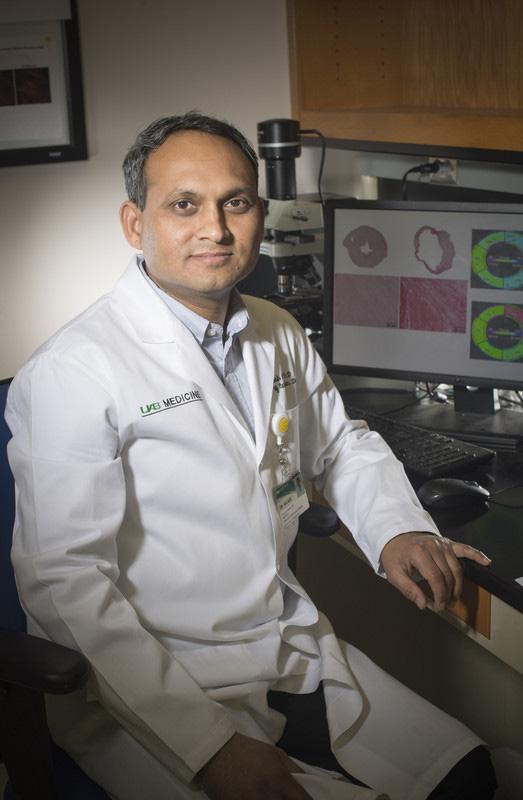Experiments with mice show involvement of gut bacteria and spleen in this heart pathology

Credit: UAB
BIRMINGHAM, Ala. – Growing older and a high-fat diet enriched with omega 6 fatty acids are major contributors to health risks ranging from diabetes to heart failure. How these two factors regulate the immune response is not well-understood.
Ganesh Halade, Ph.D., and colleagues at the University of Alabama at Birmingham and other institutions have investigated how aging and an obesity-generating omega 6-enriched diet impact microflora in the gut, the structure and function of the spleen, and a subsequent immune response to heart attack, using a mouse model.
In a study published in the FASEB Journal, they report that a calorie-dense, obesity-generating diet in aging mice disrupted the composition of the gut microbiome, and that correlated with development of a systemwide nonresolving inflammation in acute heart failure, with disruptions of the immune cell profile — notably the neutrophil-leukocyte ratio.
Halade is an associate professor in the Division of Cardiovascular Disease, UAB Department of Medicine.
It is known that diet interacts with gut microbes to calibrate the body’s immune defense capacity. The UAB-led researchers examined this further, with regard to aging and a high-fat diet.
They found that the obesity-generating diet caused a sharp increase in bacteria belonging to the genus Allobaculum, phylum Firmicutes. The obesity-generating diet also increased the proportion of neutrophils in the blood of young mice. In aged mice, a similar increase in the proportion of neutrophils was found for both old mice fed a standard diet and old mice fed the obesity-generating diet.
The spleen, a secondary immune organ, is a known reservoir for leukocytes that are released after heart injury. Those splenic leukocytes move to the heart to begin tissue repair and help resolve inflammation.
Halade and colleagues found that the obesity-generating diet and aging led to neutrophil swarming and an altered leukocyte profile after heart attack. They also observed splenic structural deformities in these mice and a decrease in splenic CD169-positive macrophages.
Importantly, young mice fed the obesity-generating diet were able to resolve inflammation after a heart attack, even though their gut microflora had already been altered by the diet. In contrast, in aged mice fed the obesity-generating diet, the heart attack triggered nonresolving inflammation. Such inflammation is associated with heart failure.
“Thus, the data strongly indicate that the obesity-generating diet develops an inflammatory microenvironment, even in young mice, that amplifies with aging,” Halade said. “This study highlights that diet and age are critical factors that have differential impact with age, and it highlights the spleen and heart as an inter-organ communication system with the immune defense system.”
###
UAB co-authors with Halade of the study, “Obesogenic diet in aging mice disrupts gut microbe composition and alters neutrophil:lymphocyte ratio, leading to inflamed milieu in acute heart failure,” are Vasundhara Kain, Division of Cardiovascular Disease, Department of Medicine; William Van Der Pol, Biomedical Informatics, Center for Clinical and Translational Science; Nithya Mariappan and Aftab Ahmad, Department of Anesthesiology and Perioperative Medicine; and Peter Eipers and Casey Morrow, Department of Cell, Developmental and Integrative Biology.
International co-authors are Deanna L. Gibson, University of British Columbia Okanagan, Canada; Cecile Gladine, Université Clermont Auvergne, France; and Claire Vigor and Thierry Durand, University of Montpellier, France.
Support came from National Institutes of Health grants AT006704 and HL132989, a UAB Pittman Scholar Award, and the American Heart Association postdoctoral fellowship POST31000008.
Media Contact
Jeff Hansen
[email protected]
Original Source
https:/
Related Journal Article
http://dx.




